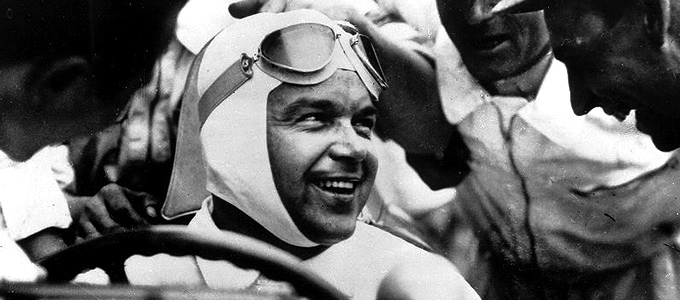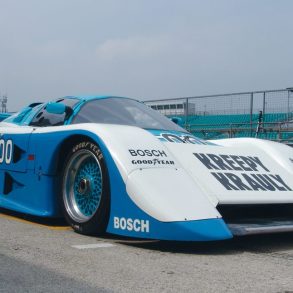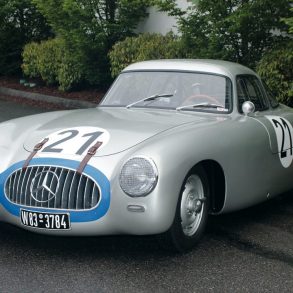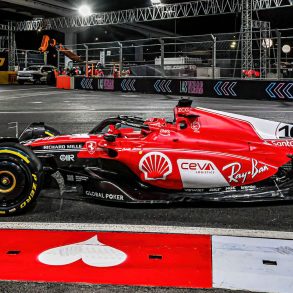Rudolf Caracciola Biography

The following year 
After convincing the general manager at Daimler to lend him a factory racecar he was required to enter the Grand Prix of Germany at Avus under his own name. This 25-year-old weekend racer started the most important race of his young career and promptly stalled his car. His mechanic Otto Salzar was forced to jump out and push start the lonely Mercedes. At last the car sputtered to life. Starting from dead last in a 44-car field was not what the young Caracciola had in mind. Shortly it began to rain and cars were flying off the track. One crashed into a timekeeper’s stand and killed the course worker.
The 500,000 spectators that were in attendence that day were to get the shock of their afternoon when it was announced that a new driver, one completely unknown to them had gone into the lead. But this lead was short lived as the Mercedes began to suffer from serious misfire. Caracciola pulled into the pits and in those days the driver had to do any repairs required on the car so Caracciola pulled each of the eight spark plugs out one by one. It was not until the last plug did he discover the culprit. By then it seamed that all was lost and he was urged to quit. Caracciola would hear none of this and chose to continue spurred on by a sense of duty to the factory.
By the 13th lap the rain had stopped but Caracciola had no sense of his position but still he soldiered on. After driving flat-out for nearly three hours and 243 miles he crossed the finished line totally exhausted. Only then did he learn that he had won the first Grand Prix of Germany. Caracciola used the prize money to good use setting up a Mercedes-Benz dealership on the prestigious Kurfürstendamm in Berlin. He also married his girlfriend, Charlotte, whom he had met in 1923 while working at the Mercedes-Benz outlet in Dresden.

Racing against the cream of Great Britain, including Bentley ace Tim Birkin, he came from a five lap handicap to win the thirty lap race in a rain storm. His victory in the 1931 Mille Miglia was not equaled by another non-Italian for 24 years until Stirling Moss won it in 1955.
The starting positions were still selected by drawing lots in the 1935 Spanish Grand Prix. Caracciola would have to start from the last row. His style had always been to get to the front as quickly as possible but this time things would be a little more difficult. The flag fell and Caracciola roared off down to the first corner. Mistaking the pedal arrangement in his Grand Prix car with his touring car, he stepped on the accelerator instead of the brake. The leaders seeing this maniac charge from way behind could only give way and in spite of almost crashing out on the first corner did he garner the lead!

Still hobbled by injuries his come back victory at the Grand Prix of Tripoli had a legendary quality to it. That year he became European Champion. In 1936 he won the Grand Prix de Monaco but the year belonged to Bernd Rosemeyer and Auto Union.
Mercedes came back in 1937 and Caracciola was again European Champion. In 1938 he won the Coppa Acerbo at Pescara and won his third title. Rudolf Caracciola’s career was plagued by painful leg injuries and later ill health yet he continued to win many honors.
His battles with Bernd Rosemeyer and Auto Union ended in the World Land Speed Record for Caracciola and the tragic death of Rosemeyer. During World War II he lived in exile at his home in Lugano, Switzerland. After the war, his love of racing unabated, he continued to race through worsening health brought on by bone disease. After he retired Caracciola worked as a Mercedes-Benz salesman targeting allied troops stationed in Europe. He died at the age of 58 in 1959. According to the legendary Mercedes team manager Alfred Neubauer, with who he had a long and close relationship,
” … of all the great drivers I have known – Nuvolari, Rosemeyer, Lang, Moss or Fangio – Caracciola was the greatest of them all.”










The Full Rudolf Caracciola Story
Otto Wilhelm Rudolf Caracciola, more commonly Rudolf Caracciola, was a racing driver from Remagen, Germany. He won the European Drivers’ Championship, the pre-1950 equivalent of the modern Formula One World Championship, an unsurpassed three times. He also won the European Hillclimbing Championship three times: twice in sports cars, and once in Grand Prix cars. Caracciola raced for Mercedes-Benz during their original dominating Silver Arrows period and set speed records for the firm.
Rudolf Caracciola was born on January 30, 1901 in Remagen, Germany. He was the fourth child of Maximilian and Mathilde, who ran the Caracciola Hotel.His ancestors had migrated from Naples to the German Rhineland during the Thirty Years’ War, where Prince Bartolomeo Caracciolo had commanded the Ehrenbreitstein Fortress near Koblenz. Caracciola was interested in cars from a young age, and from his fourteenth birthday wanted to become a racing driver. He drove an “elderly 16/45 Mercedes” during the First World War and gained his driver’s license by the age of 18. After Caracciola’s graduation from school soon after the war, his father wanted him to attend university, but when he died Caracciola instead became an apprentice in the Fafnir automobile factory in Aachen.
When still a trainee at the Fafnir-Automobilwerke in Aachen, Caracciola started in the 1922 Avus race in Berlin (fourth place overall and winner in class) and the Opelbahn race in Rüsselsheim (winner).
After a scuffle with an officer of the Belgian occupying forces, Caracciola left Aachen and became a Fafnir representative in Dresden. In 1923 he won the Berlin ADAC (the principal German automobile club) race driving an Ego.
In 1923 Caracciola joined Daimler-Motoren-Gesellschaft as a car salesman at its Dresden sales outlet. He was allowed to enter races with the current Mercedes 6/25/40 hp racing car. The successes he notched up included victory in the touring car class of the 1923 ADAC Reichsfahrt rally. In 1924 he was winner in his class on several occasions and secured overall victory in the Teutoburgerwald race. That was the year he also met his future wife, Charlotte, nicknamed Charly.
In 1925 Caracciola won eight races at the wheel of the Mercedes 24/100/140 hp. In 1926 he won the German Grand Prix in a Mercedes eight-cylinder racing car. It was in this race that he first drew attention to his brilliant driving skills in adverse weather conditions; the victory was a textbook lesson in fingertip control by the “Rainmaster”, as he later came to be known. The prize money gave Caracciola economic security. He married Charly and in January 1927 opened up a Mercedes-Benz agency in Berlin, although he continued to compete in races.
In 1927 Caracciola won the race in which the new 26/170/225 hp Mercedes-Benz S model racing touring car premiered at the Nürburgring. That year he also went on to chalk up eleven overall and class wins. In 1928 Caracciola won five races in the successor model, the Mercedes-Benz SS, and he continued his winning form in the new racing tourer, the 27/180/250 hp SSK model. With the SSK he also opened the 1929 race season for Mercedes-Benz in the Monaco Grand Prix (third place). Caracciola won the International Tourist Trophy in Ireland in a Mercedes-Benz SSK in pouring rain at an average speed of 117.2 km/h.
Caracciola finished the 1930 Mille Miglia first in his class. The following year he won the race, the first foreign starter ever to do so, in a 27/240/300 hp Mercedes-Benz SSKL racing sports car. After a 16-hour drive from Brescia to Rome and back he and co-driver Wilhelm Sebastian finally crossed the finish line on April 13, 1931 as winners, posting an average speed of 101.1 km/h. In 1931 Caracciola also won the German Grand Prix at the Nürburgring – another rain-affected race – and again captured the title of European Sports Car Hillclimb Champion.



When Mercedes-Benz withdrew from racing, Caracciola went to Alfa Romeo. In the 2.6-litre monoposto he won the German and Monza Grand Prix and the 1932 Eifel race. He became European Racing Car Hillclimb Champion and International Alpine Champion. Then in 1933 Caracciola and Louis Chiron set up the independent “Scuderia C.C.”, but he suffered a serious accident during practice for the Grand Prix of Monaco. This forced him to pull out of his racing appearances for the entire year. That winter his wife was killed in an avalanche.
Daimler-Benz signed Caracciola again for the 1934 season. For the new 750-kilogram formula the Stuttgart company launched the W 25 racing car, the first Silver Arrow. At the Italian Grand Prix on April 9, Caracciola was still troubled by the effects of the injuries sustained in his accident; in first place after 59 laps, he let Luigi Fagioli replace him at the wheel, and Fagioli brought the victory safely home. At the Spanish Grand Prix on September 23, Caracciola managed a second-place finish. New competition for Mercedes-Benz arrived in the form of Auto Union. These two racing departments would dominate the championship in the coming years.
In 1935, after a long race in sweltering heat, Caracciola won the Grand Prix of Tripoli. This was followed by victories in the Eifel race and at the Grand Prix of France, Belgium, Switzerland and Spain. A second-place finish in the Grand Prix of Barcelona and third place in the German Grand Prix rounded off the year. In 1935 he was European and German racing car champion. Mercedes-Benz won nine out of 14 grand prix events that season, with Caracciola accounting for six of them.







His string of successes came to an end in 1936. Although Caracciola opened the season with a victory in Monaco – in poor weather he once again demonstrated that his reputation as “Rainmaster” was entirely justified – the redesigned W 25 with short wheelbase increasingly caused problems. “Caratsch” posted his best results subsequent to Monaco at the Grand Prix of Tunis (winner), Barcelona (second) and Tripoli (fourth). At the German Grand Prix Caracciola and co-pilot Luigi Fagioli could manage only fifth. The star of that season was Bernd Rosemeyer, who won the European championship for Auto Union.
In 1937 Caracciola returned to the pinnacle of European motorsport. The 750 kg formula was extended for another year, and Daimler-Benz developed the new W 125 racing car specifically for this season. In the monoposto Caracciola secured his second European Championship title. His racing successes that season included victories at the German, Swiss and Italian Grand Prix and the Masaryk Grand Prix of Brno. In addition, Caracciola notched up successes in the international Eifel race (second place), the German Hillclimb Grand Prix (third place), in Monaco (second place) and the Donington Grand Prix (second place). He was European Champion and also secured the title of German Road Racing Champion.
In the open-formula Avus race in Berlin on May 30, Mercedes-Benz competed with different vehicle concepts, including three W 25 fitted with aerodynamic fairings. Caracciola won the first race of the competition driving one of these streamlined cars. He married Alice Hoffmann that year.
In January 1938 record-breaking attempts were back on the agenda. Over past years, Caracciola had set several records on autobahns and oval circuits. This time on the Frankfurt-Darmstadt autobahn he attained a speed of 432.7 km/h. To this day it is the highest speed ever attained on a public road. (See Mercedes-Benz W 125 Streamliner – Profile) It was a record marred by tragedy, however, since his friend and rival Bernd Rosemeyer would die in an attempt to break Caracciola’s record in an Auto Union car.


A new formula was drawn up for the 1938 races that limited displacement to 4.5 litres without supercharger and 3 litres with supercharger. Daimler-Benz designed the new W 154 racing car for this “3-litre formula”; it developed a maximum output of 453 hp from its V12 engine. In 1938 Caracciola won the Coppa Acerbo as well as the Swiss Grand Prix. He placed second or third in the Grand Prix of Pau (with Hermann Lang), Tripoli (third), the French Grand Prix (second), the German (with Hermann Lang, second) and Italian Grand Prix (with Manfred von Brauchitsch, third). Now 37, Caracciola won the title of European Champion for the third time and consolidated his reputation as the most successful racing driver of the era.
In the Grand Prix of Tripoli, for which Daimler-Benz specially developed the 1.5-litre voiturette W 165, Caracciola took second place behind Hermann Lang – a double victory for the Silver Arrows. But the premier racing car of the season was the redesigned W 154, with which Caracciola won the German Grand Prix on July 23. In 1939 he was German road racing champion; however, the European title that year was captured by the promising young talent, Lang.





Alice and Rudolf Caracciola lived through the Second World War in their adoptive country Switzerland. Caracciola was intent on racing in America after the war ended. However, in 1946 his car crashed during practice for the Indianapolis 500. In 1952 he actively resumed racing and finished the Mille Miglia in fourth position in a Mercedes-Benz 300 SL. But a serious accident during the 1952 Grand Prix of Berne put an end to his career for good. Caracciola was dependent on a wheelchair and crutches for a long time afterwards.
In 1956 he was given responsibility for the sale of Daimler-Benz cars to Americans and Britons stationed in continental Europe. Aged just 58, Rudolf Caracciola died in Kassel on September 28, 1959. A monument was unveiled in Remagen to mark the 100th anniversary of his birth in 2001, and the banked curve at the Nürburgring was named after him.













